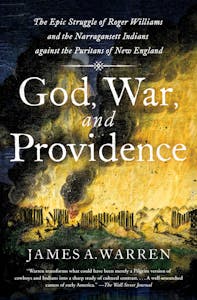The tragic and fascinating history of the first epic struggle between white settlers and Native Americans in the early seventeenth century: “a riveting historical validation of emancipatory impulses frustrated in their own time” (Booklist, starred review) as determined Narragansett Indians refused to back down and accept English authority.
A devout Puritan minister in seventeenth-century New England, Roger Williams was also a social critic, diplomat, theologian, and politician who fervently believed in tolerance. Yet his orthodox brethren were convinced tolerance fostered anarchy and courted God’s wrath. Banished from Massachusetts Bay Colony in 1635, Williams purchased land from the Narragansett Indians and laid the foundations for the colony of Rhode Island as a place where Indian and English cultures could flourish side by side, in peace.
As the seventeenth century wore on, a steadily deepening antagonism developed between an expansionist, aggressive Puritan culture and an increasingly vulnerable, politically divided Indian population. Indian tribes that had been at the center of the New England communities found themselves shunted off to the margins of the region. By the 1660s, all the major Indian peoples in southern New England had come to accept English authority, either tacitly or explicitly. All, except one: the Narragansetts.
In God, War, and Providence “James A. Warren transforms what could have been merely a Pilgrim version of cowboys and Indians into a sharp study of cultural contrast…a well-researched cameo of early America” (The Wall Street Journal). He explores the remarkable and little-known story of the alliance between Roger Williams’s Rhode Island and the Narragansett Indians, and how they joined forces to retain their autonomy and their distinctive ways of life against Puritan encroachment. Deeply researched, “Warren’s well-written monograph contains a great deal of insight into the tactics of war on the frontier” (Library Journal) and serves as a telling precedent for white-Native American encounters along the North American frontier for the next 250 years.
